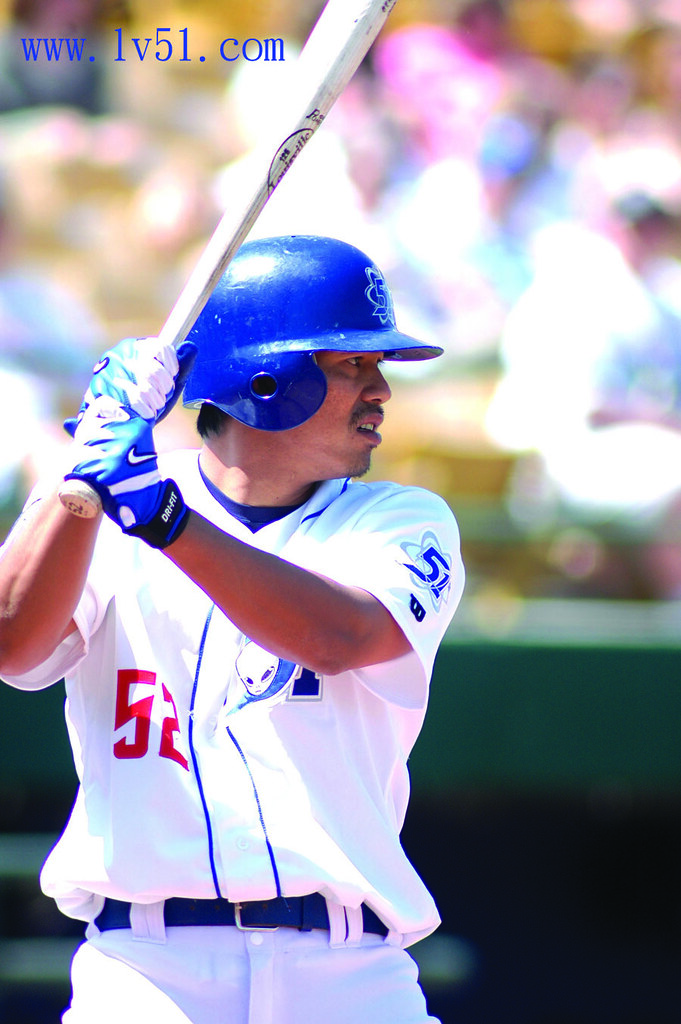 Chen was signed by the Los Angeles Dodgers for $680,000 US in 1999 and was regarded as the best Taiwanese power hitter to ever be signed by a MLB team. At 21 years old, the Dodgers aggressively started Chen in high-A San Bernadino and Chen responded to the challenge by putting up a line of .316/.404/.580. Even taking into account the fact that the California league is a notorious hitters league, Chen's line was amazing especially since this was his first prolonged exposure to American baseball and culture. Chen displayed many traits you could ask for in a good hitter: high average, good walk rate, big power and he even stole 31 bases in 38 tries. He projected as a 30-30 player and after the season Baseball America named Chen its #17 overall prospect.
Chen was signed by the Los Angeles Dodgers for $680,000 US in 1999 and was regarded as the best Taiwanese power hitter to ever be signed by a MLB team. At 21 years old, the Dodgers aggressively started Chen in high-A San Bernadino and Chen responded to the challenge by putting up a line of .316/.404/.580. Even taking into account the fact that the California league is a notorious hitters league, Chen's line was amazing especially since this was his first prolonged exposure to American baseball and culture. Chen displayed many traits you could ask for in a good hitter: high average, good walk rate, big power and he even stole 31 bases in 38 tries. He projected as a 30-30 player and after the season Baseball America named Chen its #17 overall prospect.Chen was promoted to AA San Antonio in 2000, but only posted a line of .277/.355/.376. The huge drop in power was due to a shoulder injury that he battled through for most of the season (BJ Upton of the Tampa Bay Rays had similar shoulder problems and saw his power disappear).
By 2001 Chen had recovered from his shoulder injury and rebounded to post a combined line of .290/.390/.523 between high A and AA. He showed most of the traits that made him a top prospect in 1999. However, his stolen base total dropped to a meager 7. In many cases this indicates a drop in athleticism. Reduced athleticism usually means a player has peaked athletically and will only decline afterwards resulting in poor defense, low BA, and high strikeouts. Chen was already slated for an outfield corner and without good defense he would have to hit at a very high level to earn a promotion to the majors.
2002 would be a make or break year for Chen as he was promoted to AAA Las Vegas. While he posted decent numbers of .284/.352/.503 what was troubling was that his plate discipline had started to deteriorate and his struck out an astounding 160 times. Generally, players that strike out that much have a hard time hitting .250 in the majors. The Dodgers were no doubt frightened by the strike outs and despite a brief callup to the majors chose to have him repeat AAA in 2003.
Chen managed to put at good numbers in 2003-2004, but several factors conspired against his elevation to the majors in a starting role. 25-26 year old AAA sluggers are expected to rake and anything less than a .300/400/.600 won't get you a lot of attention considering you are 2-3 years older than most of other players. Also the Dodgers were involved in a pennant race both years and already had Jeromy Burnitz and Jayson Werth in LF, both much more highly regarded than Chen. Chen posted a modest .278/.354/.495 in 2005 and without a starting role in the majors forthcoming, he elected to return home to Taiwan.
So why did Chen never become a feared slugger in the middle of a championship caliber team? Major league left fielders generally come in two varieties. Sluggers like Matt Holliday and Manny Ramirez who give up their fair share of doubles in the field but make up for it by hitting home runs. Or speedy defensive specialists like Brett Gardner. Chen's rapid drop in athleticism killed what speed he had, reducing him to well below average, and his arm was never considered to be even average (reducing any chance of him playing RF). Then given his declining plate discipline and high strikeouts, were he given the chance to start in LA in 2003 he probably would have only posted a line of .250/.310/.450. Combined with his negative defensive contribution, that puts him at replacement level, meaning there are probably 30 other players in AAA that could put up similar numbers in the majors. In the end, Chen probably peaked early and didn't have enough secondary skills to maintain himself as a top prospect.
(PS: Thanks to Jim Gemma from Las Vegas 51s for providing photos on Chin-Feng Chen.)





沒有留言:
張貼留言